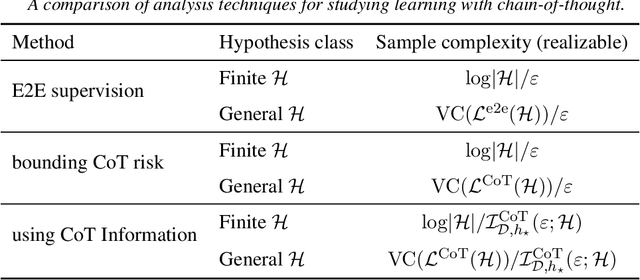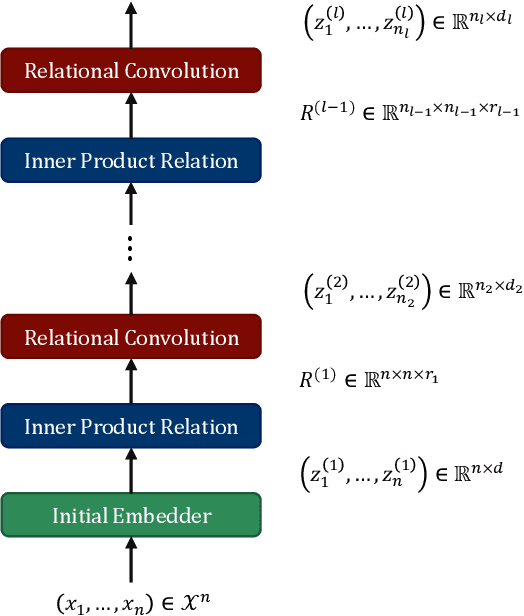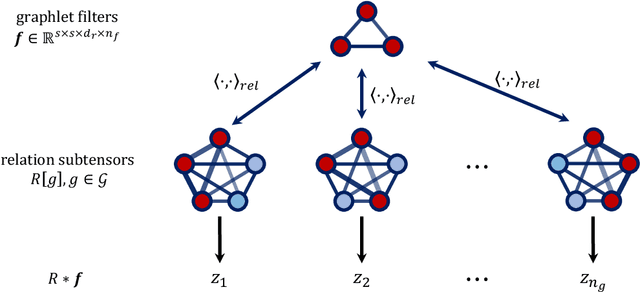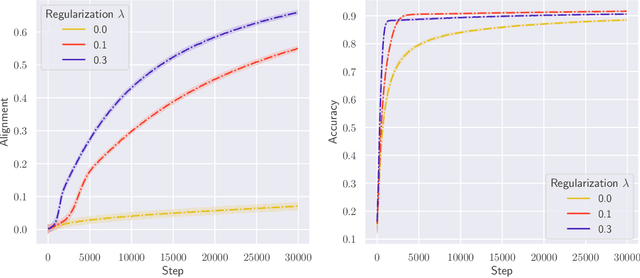John Lafferty
University of Chicago
Unlocking Out-of-Distribution Generalization in Transformers via Recursive Latent Space Reasoning
Oct 15, 2025Abstract:Systematic, compositional generalization beyond the training distribution remains a core challenge in machine learning -- and a critical bottleneck for the emergent reasoning abilities of modern language models. This work investigates out-of-distribution (OOD) generalization in Transformer networks using a GSM8K-style modular arithmetic on computational graphs task as a testbed. We introduce and explore a set of four architectural mechanisms aimed at enhancing OOD generalization: (i) input-adaptive recurrence; (ii) algorithmic supervision; (iii) anchored latent representations via a discrete bottleneck; and (iv) an explicit error-correction mechanism. Collectively, these mechanisms yield an architectural approach for native and scalable latent space reasoning in Transformer networks with robust algorithmic generalization capabilities. We complement these empirical results with a detailed mechanistic interpretability analysis that reveals how these mechanisms give rise to robust OOD generalization abilities.
CoT Information: Improved Sample Complexity under Chain-of-Thought Supervision
May 21, 2025



Abstract:Learning complex functions that involve multi-step reasoning poses a significant challenge for standard supervised learning from input-output examples. Chain-of-thought (CoT) supervision, which provides intermediate reasoning steps together with the final output, has emerged as a powerful empirical technique, underpinning much of the recent progress in the reasoning capabilities of large language models. This paper develops a statistical theory of learning under CoT supervision. A key characteristic of the CoT setting, in contrast to standard supervision, is the mismatch between the training objective (CoT risk) and the test objective (end-to-end risk). A central part of our analysis, distinguished from prior work, is explicitly linking those two types of risk to achieve sharper sample complexity bounds. This is achieved via the *CoT information measure* $\mathcal{I}_{\mathcal{D}, h_\star}^{\mathrm{CoT}}(\epsilon; \calH)$, which quantifies the additional discriminative power gained from observing the reasoning process. The main theoretical results demonstrate how CoT supervision can yield significantly faster learning rates compared to standard E2E supervision. Specifically, it is shown that the sample complexity required to achieve a target E2E error $\epsilon$ scales as $d/\mathcal{I}_{\mathcal{D}, h_\star}^{\mathrm{CoT}}(\epsilon; \calH)$, where $d$ is a measure of hypothesis class complexity, which can be much faster than standard $d/\epsilon$ rates. Information-theoretic lower bounds in terms of the CoT information are also obtained. Together, these results suggest that CoT information is a fundamental measure of statistical complexity for learning under chain-of-thought supervision.
Disentangling and Integrating Relational and Sensory Information in Transformer Architectures
May 26, 2024



Abstract:The Transformer architecture processes sequences by implementing a form of neural message-passing that consists of iterative information retrieval (attention), followed by local processing (position-wise MLP). Two types of information are essential under this general computational paradigm: "sensory" information about individual objects, and "relational" information describing the relationships between objects. Standard attention naturally encodes the former, but does not explicitly encode the latter. In this paper, we present an extension of Transformers where multi-head attention is augmented with two distinct types of attention heads, each routing information of a different type. The first type is the standard attention mechanism of Transformers, which captures object-level features, while the second type is a novel attention mechanism we propose to explicitly capture relational information. The two types of attention heads each possess different inductive biases, giving the resulting architecture greater efficiency and versatility. The promise of this approach is demonstrated empirically across a range of tasks.
Approximation of relation functions and attention mechanisms
Feb 13, 2024Abstract:Inner products of neural network feature maps arises in a wide variety of machine learning frameworks as a method of modeling relations between inputs. This work studies the approximation properties of inner products of neural networks. It is shown that the inner product of a multi-layer perceptron with itself is a universal approximator for symmetric positive-definite relation functions. In the case of asymmetric relation functions, it is shown that the inner product of two different multi-layer perceptrons is a universal approximator. In both cases, a bound is obtained on the number of neurons required to achieve a given accuracy of approximation. In the symmetric case, the function class can be identified with kernels of reproducing kernel Hilbert spaces, whereas in the asymmetric case the function class can be identified with kernels of reproducing kernel Banach spaces. Finally, these approximation results are applied to analyzing the attention mechanism underlying Transformers, showing that any retrieval mechanism defined by an abstract preorder can be approximated by attention through its inner product relations. This result uses the Debreu representation theorem in economics to represent preference relations in terms of utility functions.
Relational Convolutional Networks: A framework for learning representations of hierarchical relations
Oct 05, 2023



Abstract:A maturing area of research in deep learning is the development of architectures that can learn explicit representations of relational features. In this paper, we focus on the problem of learning representations of hierarchical relations, proposing an architectural framework we call "relational convolutional networks". Given a sequence of objects, a "multi-dimensional inner product relation" module produces a relation tensor describing all pairwise relations. A "relational convolution" layer then transforms the relation tensor into a sequence of new objects, each describing the relations within some group of objects at the previous layer. Graphlet filters, analogous to filters in convolutional neural networks, represent a template of relations against which the relation tensor is compared at each grouping. Repeating this yields representations of higher-order, hierarchical relations. We present the motivation and details of the architecture, together with a set of experiments to demonstrate how relational convolutional networks can provide an effective framework for modeling relational tasks that have hierarchical structure.
The Relational Bottleneck as an Inductive Bias for Efficient Abstraction
Sep 12, 2023

Abstract:A central challenge for cognitive science is to explain how abstract concepts are acquired from limited experience. This effort has often been framed in terms of a dichotomy between empiricist and nativist approaches, most recently embodied by debates concerning deep neural networks and symbolic cognitive models. Here, we highlight a recently emerging line of work that suggests a novel reconciliation of these approaches, by exploiting an inductive bias that we term the relational bottleneck. We review a family of models that employ this approach to induce abstractions in a data-efficient manner, emphasizing their potential as candidate models for the acquisition of abstract concepts in the human mind and brain.
Abstractors: Transformer Modules for Symbolic Message Passing and Relational Reasoning
Apr 01, 2023



Abstract:A framework is proposed that casts relational learning in terms of transformers, implementing binding between sensory states and abstract states with relational cross attention mechanisms.
From seeing to remembering: Images with harder-to-reconstruct representations leave stronger memory traces
Feb 21, 2023Abstract:Much of what we remember is not due to intentional selection, but simply a by-product of perceiving. This raises a foundational question about the architecture of the mind: How does perception interface with and influence memory? Here, inspired by a classic proposal relating perceptual processing to memory durability, the level-of-processing theory, we present a sparse coding model for compressing feature embeddings of images, and show that the reconstruction residuals from this model predict how well images are encoded into memory. In an open memorability dataset of scene images, we show that reconstruction error not only explains memory accuracy but also response latencies during retrieval, subsuming, in the latter case, all of the variance explained by powerful vision-only models. We also confirm a prediction of this account with 'model-driven psychophysics'. This work establishes reconstruction error as a novel signal interfacing perception and memory, possibly through adaptive modulation of perceptual processing.
Emergent organization of receptive fields in networks of excitatory and inhibitory neurons
May 26, 2022Abstract:Local patterns of excitation and inhibition that can generate neural waves are studied as a computational mechanism underlying the organization of neuronal tunings. Sparse coding algorithms based on networks of excitatory and inhibitory neurons are proposed that exhibit topographic maps as the receptive fields are adapted to input stimuli. Motivated by a leaky integrate-and-fire model of neural waves, we propose an activation model that is more typical of artificial neural networks. Computational experiments with the activation model using both natural images and natural language text are presented. In the case of images, familiar "pinwheel" patterns of oriented edge detectors emerge; in the case of text, the resulting topographic maps exhibit a 2-dimensional representation of granular word semantics. Experiments with a synthetic model of somatosensory input are used to investigate how the network dynamics may affect plasticity of neuronal maps under changes to the inputs.
Convergence and Alignment of Gradient Descent with Random Back Propagation Weights
Jun 14, 2021


Abstract:Stochastic gradient descent with backpropagation is the workhorse of artificial neural networks. It has long been recognized that backpropagation fails to be a biologically plausible algorithm. Fundamentally, it is a non-local procedure -- updating one neuron's synaptic weights requires knowledge of synaptic weights or receptive fields of downstream neurons. This limits the use of artificial neural networks as a tool for understanding the biological principles of information processing in the brain. Lillicrap et al. (2016) propose a more biologically plausible "feedback alignment" algorithm that uses random and fixed backpropagation weights, and show promising simulations. In this paper we study the mathematical properties of the feedback alignment procedure by analyzing convergence and alignment for two-layer networks under squared error loss. In the overparameterized setting, we prove that the error converges to zero exponentially fast, and also that regularization is necessary in order for the parameters to become aligned with the random backpropagation weights. Simulations are given that are consistent with this analysis and suggest further generalizations. These results contribute to our understanding of how biologically plausible algorithms might carry out weight learning in a manner different from Hebbian learning, with performance that is comparable with the full non-local backpropagation algorithm.
 Add to Chrome
Add to Chrome Add to Firefox
Add to Firefox Add to Edge
Add to Edge